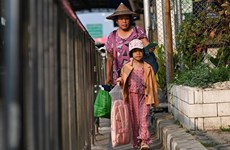WB warns of losses from disasters in East Asia-Pacific
Rapidly growing cities are becoming increasingly vulnerable to disasters
in the East Asia-Pacific region due to poor planning, with economic
losses increasing dramatically as the region grows wealthier, says a new
World Bank report.
Rapidly growing cities are becoming increasingly vulnerable to disasters
in the East Asia-Pacific region due to poor planning, with economic
losses increasing dramatically as the region grows wealthier, says a new
World Bank report.
Policymakers can make a significant difference to ensure that progress in development and poverty reduction are not lost by acting now to build resilience, said the report entitled “Strong, Safe and Resilient - A Strategic Policy Guide for Disaster Risk Management in East Asia and the Pacific”.
Investing in disaster preparedness from strengthening hazard forecast services to restoring natural ecosystems, can be surprisingly cost-effective, it added.
“East Asia-Pacific is the region that is most affected by cyclones, tsunamis, earthquakes and floods. To confront these disaster challenges, governments need to be prepared for the unexpected and undertake major investments in disaster risk management and resilience,” the WB’s press release on June 3 quoted WB East Asia and Pacific Vice President Axel van Trotsenburg as saying.
They should make disaster risk management part of poverty alleviation and sustainable development because the poor are disproportionately affected by disasters, he added.
“We are working with governments and partners to strengthen financial resilience against disasters,” said the WB’s East Asia and Pacific Chief Economist Bert Hofman.
More needs to be done to improve catastrophe risk modelling tools to help governments assess budgetary impacts of disasters, and to develop disaster risk financing strategies, he said.
The WB has suggested short, medium and long-term solutions for the countries in the region to minimise the impact of disasters, focusing on forecasting and investing in early warning systems, strengthening cooperation, improving infrastructure and urban planning.-VNA
Policymakers can make a significant difference to ensure that progress in development and poverty reduction are not lost by acting now to build resilience, said the report entitled “Strong, Safe and Resilient - A Strategic Policy Guide for Disaster Risk Management in East Asia and the Pacific”.
Investing in disaster preparedness from strengthening hazard forecast services to restoring natural ecosystems, can be surprisingly cost-effective, it added.
“East Asia-Pacific is the region that is most affected by cyclones, tsunamis, earthquakes and floods. To confront these disaster challenges, governments need to be prepared for the unexpected and undertake major investments in disaster risk management and resilience,” the WB’s press release on June 3 quoted WB East Asia and Pacific Vice President Axel van Trotsenburg as saying.
They should make disaster risk management part of poverty alleviation and sustainable development because the poor are disproportionately affected by disasters, he added.
“We are working with governments and partners to strengthen financial resilience against disasters,” said the WB’s East Asia and Pacific Chief Economist Bert Hofman.
More needs to be done to improve catastrophe risk modelling tools to help governments assess budgetary impacts of disasters, and to develop disaster risk financing strategies, he said.
The WB has suggested short, medium and long-term solutions for the countries in the region to minimise the impact of disasters, focusing on forecasting and investing in early warning systems, strengthening cooperation, improving infrastructure and urban planning.-VNA












